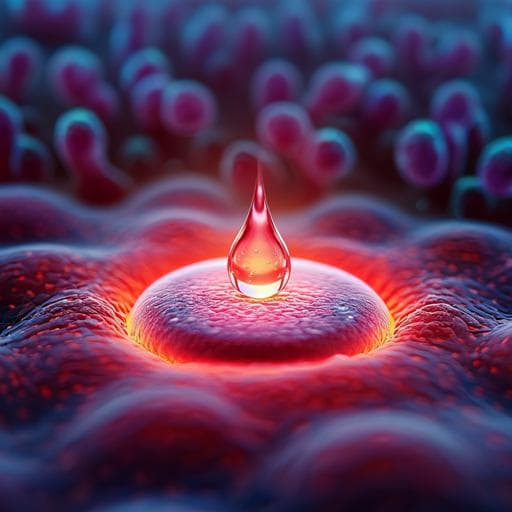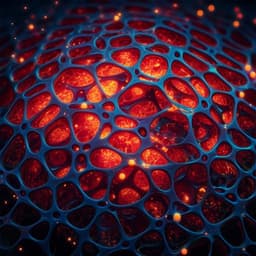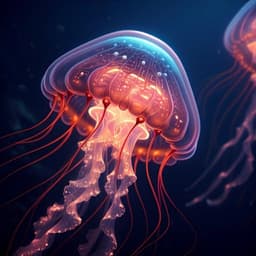
Engineering and Technology
A microscale soft lithium-ion battery for tissue stimulation
Y. Zhang, T. Sun, et al.
This groundbreaking research introduces a microscale soft flexible lithium-ion droplet battery (LiDB) made from biocompatible silk hydrogel, showcasing its unique abilities in triggerable activation, biocompatibility, and high capacity. Conducted by Yujia Zhang, Tianyi Sun, Xingyun Yang, Linna Zhou, Cheryl M. J. Tan, Ming Lei, and Hagan Bayley, the LiDB powers innovative applications such as electrophoretic translocation of charged molecules, heart defibrillation, and magnetically-enabled propulsion.
~3 min • Beginner • English
Introduction
The study addresses the need for miniature, soft, biocompatible, and potentially biodegradable power sources to match the rapid miniaturization of electronics, especially for biomedical applications. Existing hydrogel-based lithium-ion batteries offer some desirable properties but lack true microscale architectures that self-assemble cathode, separator, and anode at submillimeter scales; prior methods required manual assembly of precrosslinked compartments or multi-step deposition, limiting size reduction and energy density. Earlier droplet-based ionic power sources (eel-inspired) generated ionic currents from salt gradients but suffered from low power, incomplete rechargeability, complex activation (temperature-triggered gelation and oil-mediated buffer exchange), and were limited to ionic outputs insufficient for organ-level stimulation. This work proposes and demonstrates a rechargeable lithium-ion droplet battery (LiDB) assembled from lipid-supported silk hydrogel droplets that can be UV-triggered to activate, delivering higher energy density and stable electrical output suitable for interfacing with synthetic tissues and ex vivo hearts, while retaining softness, biocompatibility, biodegradability, and optional magnetic maneuverability.
Literature Review
Prior work includes 3D printing and micro-origami approaches to miniaturized batteries, and hydrogel-based Li-ion batteries demonstrating flexibility and biocompatibility but relying on macroscopic casting and assembly (hindering microscale integration and high-density energy storage). A miniaturized eel-inspired ionic power source using lipid-supported hydrogel droplets generated ionic currents from internal gradients and modulated neural microtissues, but was not fully rechargeable, produced lower power than conventional Li-ion systems, required temperature-triggered activation with oil exchanges, and provided only ionic outputs inadequate for organ-level modulation. The current study builds upon lipid-supported droplet networks and synthetic tissue interfaces to realize a microscale, rechargeable Li-ion system with improved output, triggerable activation, and functional interfacing with biological systems.
Methodology
Design and materials: The LiDB consists of three silk hydrogel droplets: a cathode droplet containing LiMn2O4 (LMO) particles and carbon nanotubes (CNTs), a central separator droplet containing LiCl electrolyte, and an anode droplet containing Li4Ti5O12 (LTO) particles and CNTs. Silk fibroin (50 mg ml−1) provides the hydrogel scaffold. Pregels are prepared by mixing silk solution with: separator (1 M LiCl, 10% v/v PEG 400, 0.5% w/v Pluronic F-68), cathode (separator components + 30% v/v CNT dispersion and 10% w/v LMO), anode (separator components + 30% v/v CNT dispersion and 10% w/v carbon-coated LTO). Tris(bipyridine)ruthenium(II) chloride (1 mM) and sodium persulfate (5 mM) are added for photo-crosslinking.
Lipid-supported droplet assembly: Pregel droplets are deposited into a lipid-containing hexadecane oil (4 mM total lipids DPhPC:POPC 2:1) using a programmable microinjector with glass nozzles, forming nanoliter–microliter droplets. Droplets acquire lipid monolayers; when placed in contact they form droplet interface bilayers (DIBs) within seconds, stabilizing the free-standing, compartmentalized assembly.
Activation by UV: To activate the battery, droplets are irradiated with 365 nm UV (>0.5 mW cm−2) for 60 s to induce Ru/SPS-mediated dityrosine crosslinking of silk, rupturing DIBs and forming a continuous hydrogel network that conducts Li+ between electrodes while CNTs interconnect Li particles to facilitate electron transport.
Device characterization: Carbon fiber or gold microelectrodes contact the hydrogel cathode and anode. Electrochemical testing uses a Metrohm DropSens workstation (cyclic voltammetry; galvanostatic charge–discharge; impedance). Three-electrode tests use Ag/AgCl reference and activated carbon counter. Mechanical and physicochemical characterization includes FTIR (ATR), zeta potential (~−20.2 mV), compression modulus (~10 kPa at 80% compression), and conductivity (~41.3 mS cm−2 between electrodes). Storage tests in oil assess stability (≥48 h) pre-activation.
Miniaturization and scaling: Droplets as small as 0.5 nl (~100 µm diameter) can be printed; typical experiments use 10 nl to microliter volumes. Series connection of multiple LiDB units is implemented in a custom resin well with screen-printed carbon electrodes on the base to increase voltage output.
Electron-to-ion conversion for tetherless molecule transport: Converting hydrogel droplets are formulated with 2% w/v low-gelling agarose, 0.1 M KCl, and 1.1% w/v PEDOT:PSS to transduce electron current from LiDB into ionic flux. These are attached to LiDB cathode/anode in lipid-free oil and then coupled to either hydrogel droplets (no DIBs) or aqueous synthetic cells (with DIBs incorporating α-hemolysin pores) to drive electrophoresis of charged fluorophores (pyronin Y, MANT-dATP). Fluorescence imaging quantifies translocation over 10 min.
Ex vivo heart preparation and stimulation: Langendorff-perfused murine hearts (WT and PnmtCre/ChR2) are maintained at 37 °C with oxygenated Krebs solution. ECG is recorded with epicardial electrodes (5–500 Hz bandpass, 1 kHz sampling). For quantifying direct-contact electrical shock/defibrillation, a fully charged single LiDB (various droplet volumes) is gently placed on the epicardium; adhesive silk ensures attachment. Optogenetic pacing (470 nm, 5 ms pulses) in PnmtCre/ChR2 hearts regularizes rhythm to isolate LiDB-triggered events. Ventricular arrhythmias are induced by ouabain perfusion (300 µl, 0.3 mg ml−1) with high-frequency burst pacing, then defibrillation is attempted by attaching/detaching the LiDB. Separate tests apply known DC (15–45 µA) via electrodes to benchmark LiDB shock equivalence.
Magnetic maneuverability and cross-phase operation: For magnetic control, 10% v/v nickel particles are added to the separator droplet. A neodymium magnet mounted on a micromanipulator steers LiDBs through oil mazes between recharging and target electrodes, and from oil into aqueous LiCl (1 M) baths. Charge delivery is monitored at target electrodes; a 2 mF capacitor is charged across cycles. Performance in oil vs aqueous media is compared; organogel encapsulation is suggested for long-term physiological operation. Biodegradation in aqueous PBS is assessed with proteinase K (30 U ml−1) at 37 °C, monitoring silk degradation over ~20–30 min.
Biocompatibility assays: Fully charged LiDBs (1 µl droplets) are co-cultured with mouse 3T3 fibroblasts (GFP+), human dermal fibroblasts, and human iPSC-derived cardiomyocytes. Live/dead imaging at 48 h, metabolic activity (MTT), cytotoxicity, and apoptosis (caspase 3/7) assays after 7 days evaluate cytocompatibility.
Key Findings
- Electrochemical performance: Three-electrode CV indicated silk hydrogel stability across working potentials with reversible redox at LMO cathode and LTO anode. At 10% w/v active material loading in both electrodes, aggregation was avoided. Galvanostatic discharge showed an average voltage plateau ~0.65 V. For 1 µl units, volumetric capacities were ~46, 27, and 17 nAh µl−1 at 0.2, 0.5, and 1 µA, respectively. Capacity retention exceeded 72% after 50 cycles at 1 µA, with recovery upon returning to 0.5 µA. Stable storage >48 h pre-activation and negligible temperature change during cycling were observed.
- Miniaturization benefit: Shrinking droplet volume from 3 µl to 10 nl increased volumetric capacity due to higher surface-to-volume ratio and enhanced coulombic efficiency, reaching ~570 nAh µl−1 at smallest sizes (~600 µm unit length), unprecedented for all-hydrogel Li-ion batteries (>10^3-fold smaller than prior art). Released charge peaked around 0.5 µl before decreasing at smaller volumes due to fewer Li particles.
- Series connection: Six LiDB units in series produced ~3.3 V open-circuit, sufficient to light three red LEDs and power a liquid-crystal display timer.
- Tetherless charged molecule translocation: With PEDOT:PSS converting droplets, LiDB current drove electrophoresis of dyes across hydrogel droplets and across DIBs via α-hemolysin pores. In 10 min, cationic pyronin Y moved toward the anode; anionic MANT-dATP moved toward the cathode. Synthetic cells with DIBs showed higher target/nontarget fluorescence ratios due to reduced diffusion.
- Ex vivo heart modulation: Direct contact of a charged LiDB on Langendorff-perfused mouse hearts produced electrical shocks at attachment/detachment, transiently disrupting intrinsic activity and restoring rhythm (unsynchronized cardioversion). Larger droplet volumes (e.g., 3 µl) increased shock amplitude and temporarily suppressed intrinsic beats. A 1 µl LiDB produced effects equivalent to ~30 µA DC stimulation. In ouabain-induced ventricular tachycardia/fibrillation, LiDB contact enabled defibrillation within ~5 s, converting to normal rhythm; repeated defibrillation was feasible. Biocompatibility assays showed no adverse effects on fibroblasts or iPSC-derived cardiomyocytes over 48 h–7 days.
- Magnetic maneuverability and energy courier: Adding Ni particles to the separator preserved capacity while enabling steering through oil mazes for repeated charging/discharging. After 10 navigation cycles at 0.5 µA (0.25 µl droplets), capacity retention was >77%. A 2 mF capacitor at target electrodes reached 0.51 V after 10 cycles, corresponding to ~1.02 mC delivered charge (~0.26 mJ). Cross-phase operation in aqueous 1 M LiCl was feasible; discharge capacity in water was ~67% of that in oil, likely due to swelling and decreased surface-to-volume ratio. The LiDB operated below water electrolysis potential. Silk hydrogel biodegraded enzymatically in minutes, leaving minimal residue.
- Energy and power density: For 10 nl droplets, output energy density was ~46 µWh cm−3 and instantaneous output power density ~10 µW cm−2, compatible with nanowatt-budget devices.
Discussion
The LiDB addresses the challenge of creating a microscale, soft, rechargeable battery that can be readily interfaced with biological systems. Lipid-supported self-assembly of silk hydrogel droplets allows submillimeter integration of cathode, separator, and anode, overcoming diffusion-driven mixing that plagues liquid precursors and enabling UV-triggered, on-demand activation. The negatively charged, elastic silk matrix supports Li+ transport, mechanical robustness, and tissue adhesion, enabling reliable operation and direct biological interfacing. Electrochemically, miniaturization enhances volumetric capacity and coulombic efficiency, while series connection provides flexible voltage scaling. Functionally, LiDBs directly power electrophoretic signaling between synthetic cells and deliver effective, localized electrical shocks for ex vivo cardiac defibrillation and pacing via a small external circuit, demonstrating potential clinical utility for low-energy, biocompatible interventions. Magnetic maneuverability extends the concept to mobile energy couriers for distributed microsystems and potential microrobotics.
The findings confirm that soft hydrogel-based Li-ion architectures can achieve unprecedented volumetric capacities at microscale, stable cycling, and practical outputs for biointerfaces. They also reveal operational feasibility in aqueous environments with manageable performance trade-offs and demonstrate biodegradation pathways for transient biomedical devices.
Conclusion
This work introduces a self-assembled, UV-activatable, microscale soft Li-ion droplet battery with biocompatible silk hydrogel architecture that achieves high volumetric capacity at submillimeter scales, stable cycling, and sufficient output to power electronics, drive electrophoretic communication in synthetic tissues, and modulate ex vivo heart rhythms. Modular additions, such as magnetic particles, enable steering and mobile energy delivery across oil and aqueous phases, and the silk matrix supports biodegradation for transient applications. Future work should address scaling production via acoustic printing or microfluidic deposition, further miniaturization to boost energy density, increasing active material loading (e.g., smaller Li particles or nozzle treatments), serial/parallel array integration for tailored voltage/current outputs, long-term encapsulation strategies for physiological environments, and adaptation to other chemistries (e.g., Zn-ion) or functional particles for broader biomedical and microrobotic applications.
Limitations
- Aqueous electrochemical stability window limits output voltage to below water electrolysis (~1.23 V), constraining single-unit voltage relative to solid-state batteries; arrays can mitigate this.
- Active material loading is limited (<20% w/v) to avoid nozzle clogging during droplet printing, capping maximum capacity; smaller particles or treated nozzles may increase loading.
- In aqueous operation, capacity decreases (~67% of oil) likely due to hydrogel swelling and reduced surface-to-volume ratio; re-propulsion back into oil is difficult due to surface tension, suggesting the need for alternative transport/encapsulation strategies.
- Long-term in vivo stability and performance under physiological flow and immune environments were not assessed; demonstrations were ex vivo or in vitro.
Related Publications
Explore these studies to deepen your understanding of the subject.







